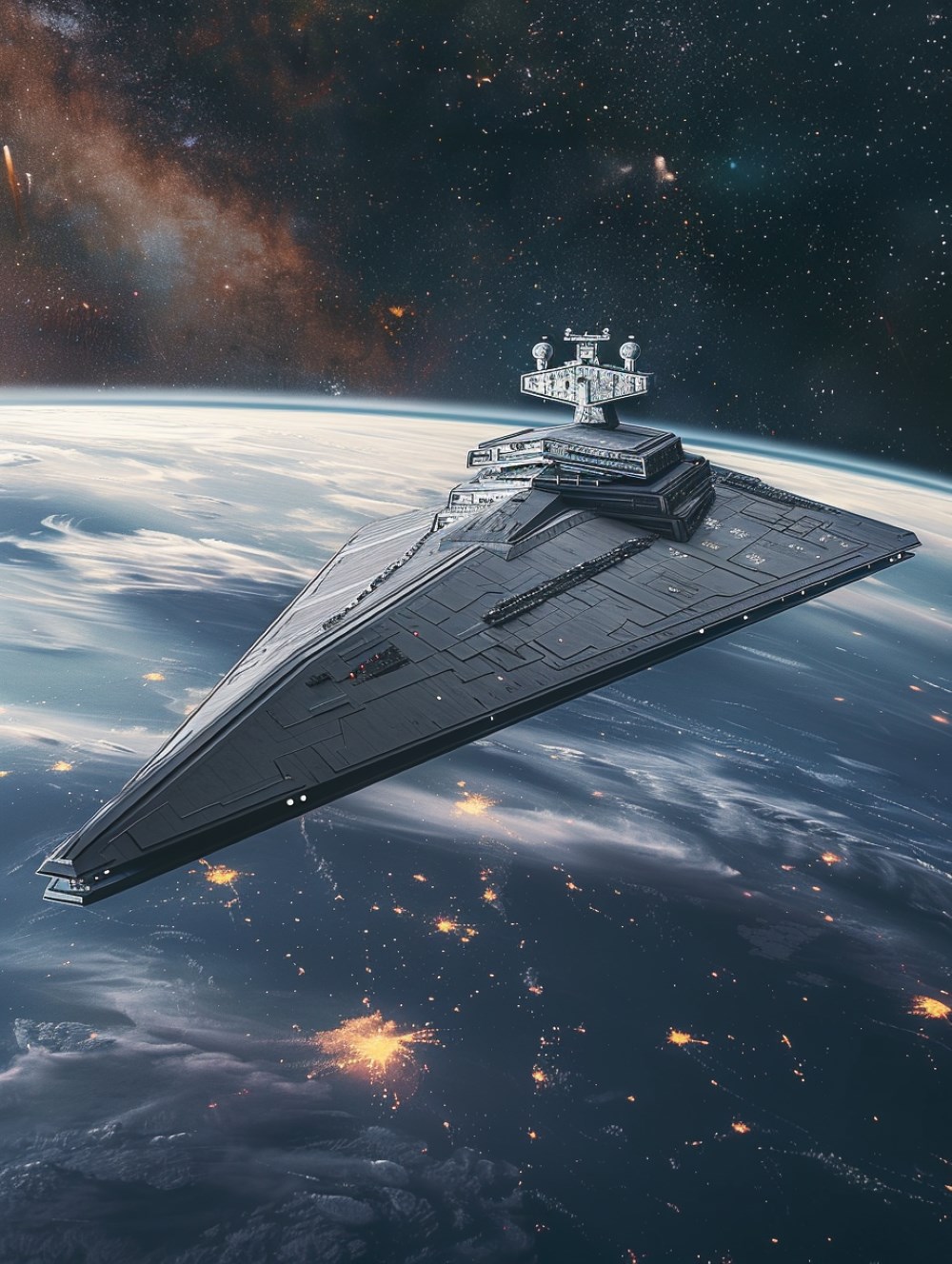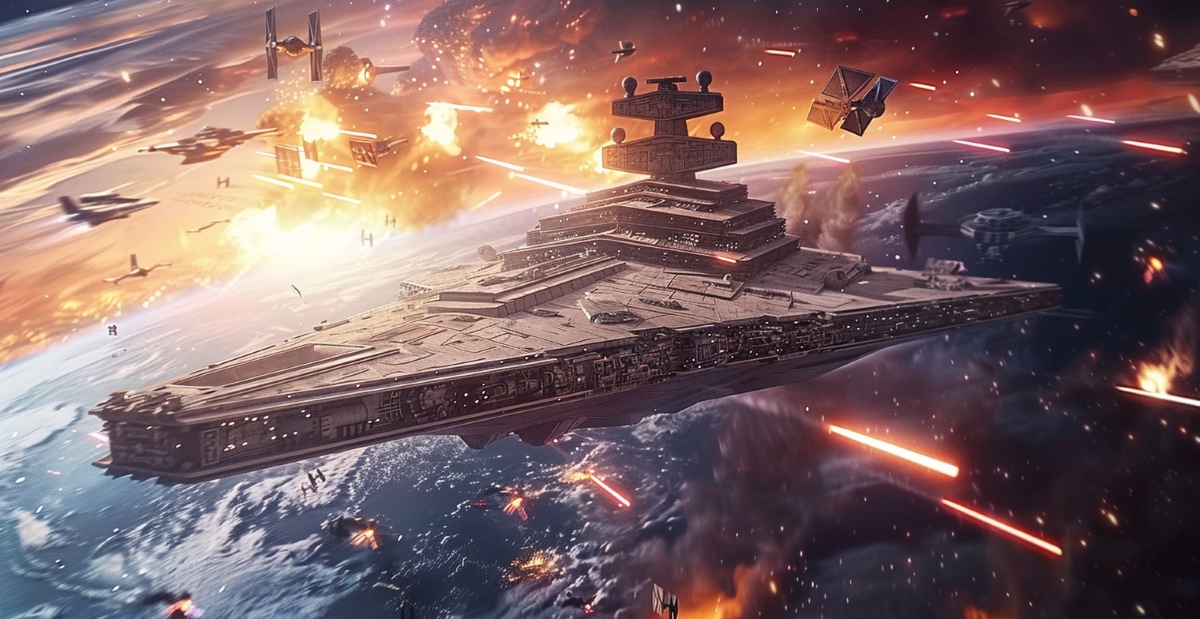In the realm of science fiction, Imperial Star Destroyers from the “Star Wars” universe represent the pinnacle of military might, complete with formidable weaponry, shielding, and a fleet of TIE fighters.
But what would happen if one were to suddenly appear in Earth’s orbit today?
Could the US military realistically stand a chance against such an advanced vessel?
Let’s dive into an analysis of how the US military might engage with an Imperial Star Destroyer.
The Challenge of Orbital Superiority
First and foremost, the Imperial Star Destroyer boasts an advantageous position by operating from orbit.

From this vantage point, it can launch attacks directly on Earth with its array of turbo lasers and ion cannons, which are designed to devastate planetary surfaces and disable spacecraft.
The US military currently lacks direct means to reach orbit quickly and engage in combat operations from space.
Existing missile defense systems like THAAD or the Aegis Ballistic Missile Defense System are designed to intercept incoming ballistic missiles, not engage a space-faring warship equipped with deflector shields.
The TIE Fighter Defense
Approaching the Star Destroyer would be a significant hurdle.
Even if the US could somehow get spacecraft or missiles close enough, they would first need to confront a squadron of TIE fighters.

These small, agile spacecraft are designed for both offensive and defensive roles and would likely pose a substantial challenge to any terrestrial aircraft or missile attacks.
The current air and missile defense systems might be able to intercept some TIE fighters, but a full squadron executing coordinated attacks could overwhelm terrestrial defenses.
Breaching the Shields
Assuming the US military could get past the TIE fighters, the next major challenge would be the Star Destroyer’s shields.
In “Star Wars,” these shields can repel both kinetic and energy-based weaponry, suggesting that conventional weapons might be ineffective.
Innovative strategies, such as electromagnetic pulses (EMPs) or other technologies designed to disrupt shield operations, would be necessary but remain largely untested in real-world scenarios against such advanced technology.
The Weaponry of the Star Destroyer
The armaments of a Star Destroyer are not to be underestimated.
Equipped with multiple heavy turbo lasers, ion cannons, and tractor beams, it possesses both offensive and defensive capabilities far beyond any technology currently deployed by Earth’s militaries.
The kinetic impact and energy displacement caused by its weapons would be catastrophic.
Current Earth technologies do not have the ability to counter such high-energy weapons effectively.
Potential Strategies for the US Military Against a Star Destroyer
Advanced Cyber Warfare
Given the advanced nature of the Star Destroyer’s onboard systems, cyber warfare could play a crucial role.
The US military might aim to develop malware or other cyber-attack strategies tailored to infiltrate the Star Destroyer’s network.
This would involve significant intelligence gathering to understand the architecture of the ship’s systems, possibly requiring the capture of peripheral Imperial techs such as droids or smaller vessels for study.
Successful cyber attacks could disable critical systems like navigation, communications, or even weapons control, creating opportunities for physical attacks or causing the ship to retreat.
Kinetic Bombardment
While traditional missiles may not penetrate the Star Destroyer’s shields, the US military could consider using kinetic bombardment—launching massive rods made of tungsten or another dense material from orbit.
Known colloquially as “Rods from God,” this approach leverages gravitational force to create high-speed impacts capable of significant destruction.
These rods, being purely kinetic, might bypass energy shields that are designed to deflect energy-based weapons, impacting vital areas of the ship directly.
Directed Energy Weapons
The US could accelerate the development of directed energy weapons, such as high-energy lasers and particle beams.
These could potentially be used to overload or destabilize the Star Destroyer’s shield systems.
By focusing these beams on a specific segment of the shield, the US military might localize the strain, creating a temporary breach for missiles or drones to exploit.
Exploiting Structural Weaknesses
Detailed analysis of any captured Imperial technology could reveal structural weaknesses similar to the exhaust port flaw in the Death Star.
These could include vulnerabilities in the thermal exhaust systems, unshielded reactor vents, or less armored sections of the hull.
Precision strikes with advanced missiles or specially designed drones could be deployed to exploit these weaknesses once identified.
Space-based Platforms and Drones
Developing space-capable platforms and drones could provide the US with a way to engage the Star Destroyer without risking manned aircraft.
These drones could be equipped with experimental weapons, such as EMPs designed to disable electronic systems temporarily.
Additionally, these platforms could serve as bases for electronic warfare, extending the reach of cyber attacks or jamming efforts against the Star Destroyer.
Alliances with Other Nations
Facing such a formidable opponent would likely encourage global cooperation.
Forming an international coalition would not only pool resources and technologies but also distribute the risk, making it a global response to a global threat.
This alliance could lead to unprecedented collaboration in space warfare technology development and strategy.
Guerrilla Tactics in Space

The US military might employ space-based guerrilla tactics, using hit-and-run attacks by smaller, more maneuverable spacecraft.
These attacks would focus on wearing down the Star Destroyer’s defenses and straining its resources, similar to terrestrial guerrilla warfare.
Small, fast ships could engage in quick strikes, retreating before facing significant retaliation.
Conclusion
The hypothetical scenario of the US military facing off against an Imperial Star Destroyer poses a fascinating but daunting challenge.
With current technology, Earth’s defenses would likely be significantly outmatched in direct combat.
The situation would require rapid innovation and deployment of space-based military assets, development of new strategies for combating above-atmosphere threats, and perhaps most importantly, a bit of the luck that seems to favor the heroes of the “Star Wars” universe.
Until such technologies and tactics can be developed, the best hope for Earth might lie in diplomacy or avoiding detection altogether.

